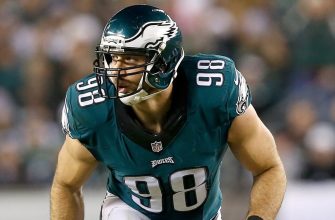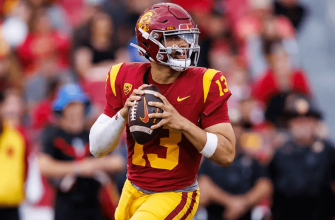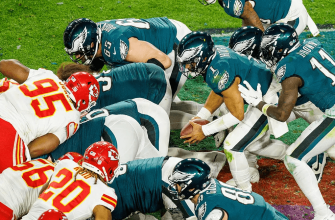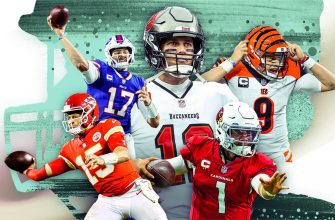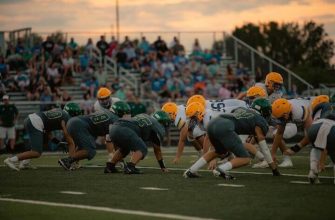An offensive lineman is one of the most important positions in football, though their work often goes unnoticed by casual fans. The offensive line is composed of 5 players – a center, two guards, and two tackles. Their main job is to block and protect the quarterback and running backs, acting as a “wall” to create running lanes and buy time for the quarterback to pass.
Though offensive linemen don’t often get the same glory as skill players who score touchdowns, they are absolutely essential to a team’s success. A strong offensive line allows an offense to control the time of possession and dictate the flow of the game. Without good blocking up front, even the most talented playmakers can’t showcase their abilities. Offensive linemen are usually the biggest players on the field and must have great size and strength to battle massive defensive linemen every play.
What Do Offensive Linemen Do?
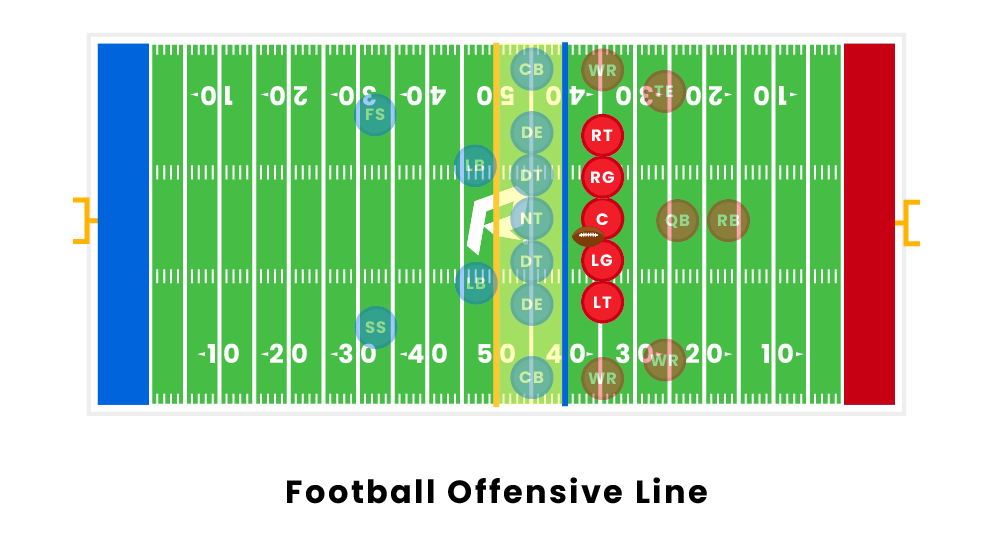
The main job of an offensive lineman in football is to protect the quarterback and make room for the running backs to advance the ball down the field. Offensive linemen are positioned on the line of scrimmage and are responsible for blocking defensive players trying to tackle the quarterback or running back.
The most important duty of an offensive lineman is to protect the quarterback from getting sacked. On passing plays, the offensive linemen use their size and strength to keep defenders away from the quarterback long enough for him to spot an open receiver and throw the ball. If an offensive lineman fails to block his assignment, it can result in a sack and potential injury to the quarterback.
Offensive linemen also play a key role on running plays. They are tasked with driving back the defensive linemen in order to open up running lanes for the running backs. A successful block by an offensive lineman allows the running back to get past the line of scrimmage and gain positive yardage. Offensive linemen use a variety of blocking techniques, leverage, and coordination to create space for the running backs to operate.
In both pass protection and run blocking situations, offensive linemen are responsible for maintaining control of the line of scrimmage. This means holding their ground and not allowing the defensive players to push them backwards into the offensive backfield. Dominating the line of scrimmage allows the rest of the offensive skill players to function and make plays.
Positions on the Offensive Line
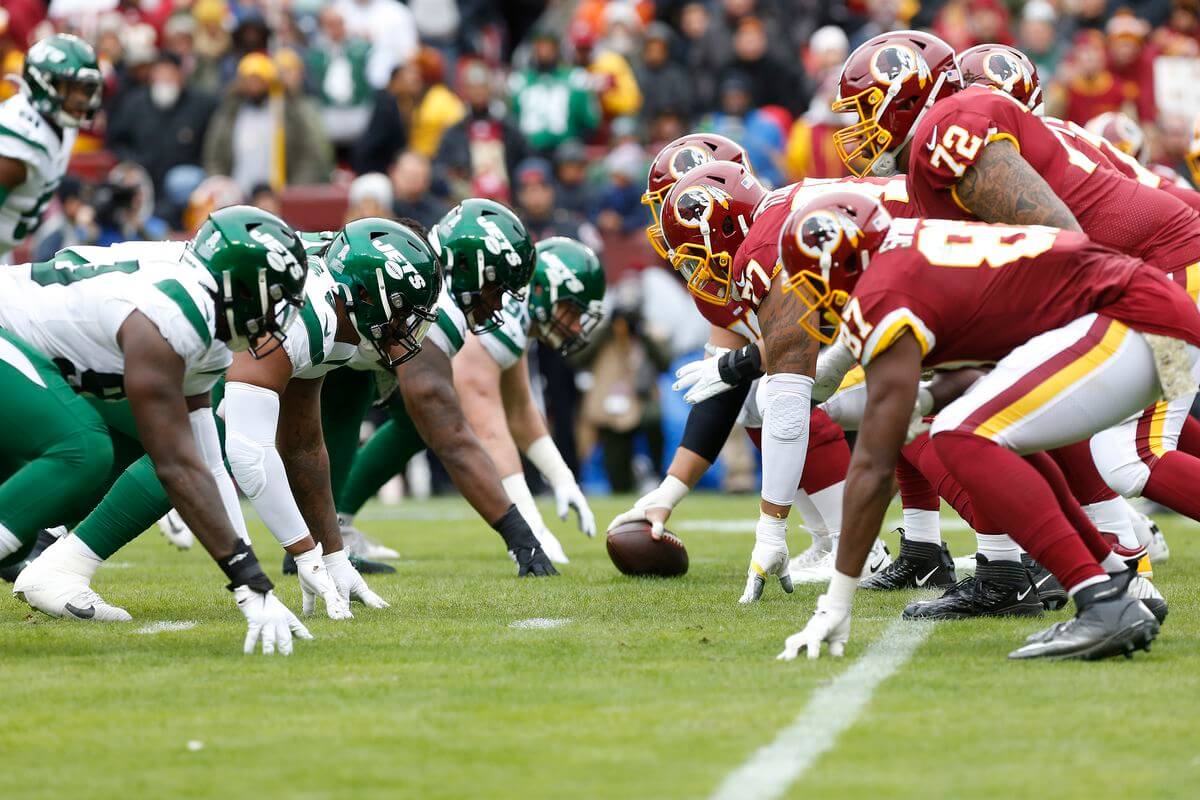
The offensive line in football consists of 5 positions – center, guards, and tackles.
Each position has a specific role and responsibilities:
Center
The center is positioned directly over the football and is often considered the leader or captain of the offensive line. The center is responsible for snapping the ball to the quarterback to start each play. After the snap, the center blocks and protects the gap between the guards. Good centers need to have quick hands and snapping ability along with strength to handle bull rushing defensive tackles.
Guards
There are two guard positions – left guard and right guard. Guards line up on either side of the center and are mainly responsible for blocking on running plays. Guards engage with defensive tackles and sometimes linebackers on inside run blocks. Good guards tend to be powerful run blockers that can drive defenders backwards.
Tackles
The two tackle positions are left tackle and right tackle. They line up on the outer edges of the guards and are primarily responsible for pass protection of the quarterback. Left tackles protect the blind side of right handed quarterbacks. Good tackles have long arms and quick feet to contain speed rushers. The left tackle is often viewed as the most critical position on the offensive line.
The cohesion of the center, guards, and tackles is crucial to forming a solid pocket and run blocking efficiently. Although each position has specific duties, the offensive line must work together harmoniously to protect the quarterback and open running lanes.
Key Attributes of a Good Offensive Lineman
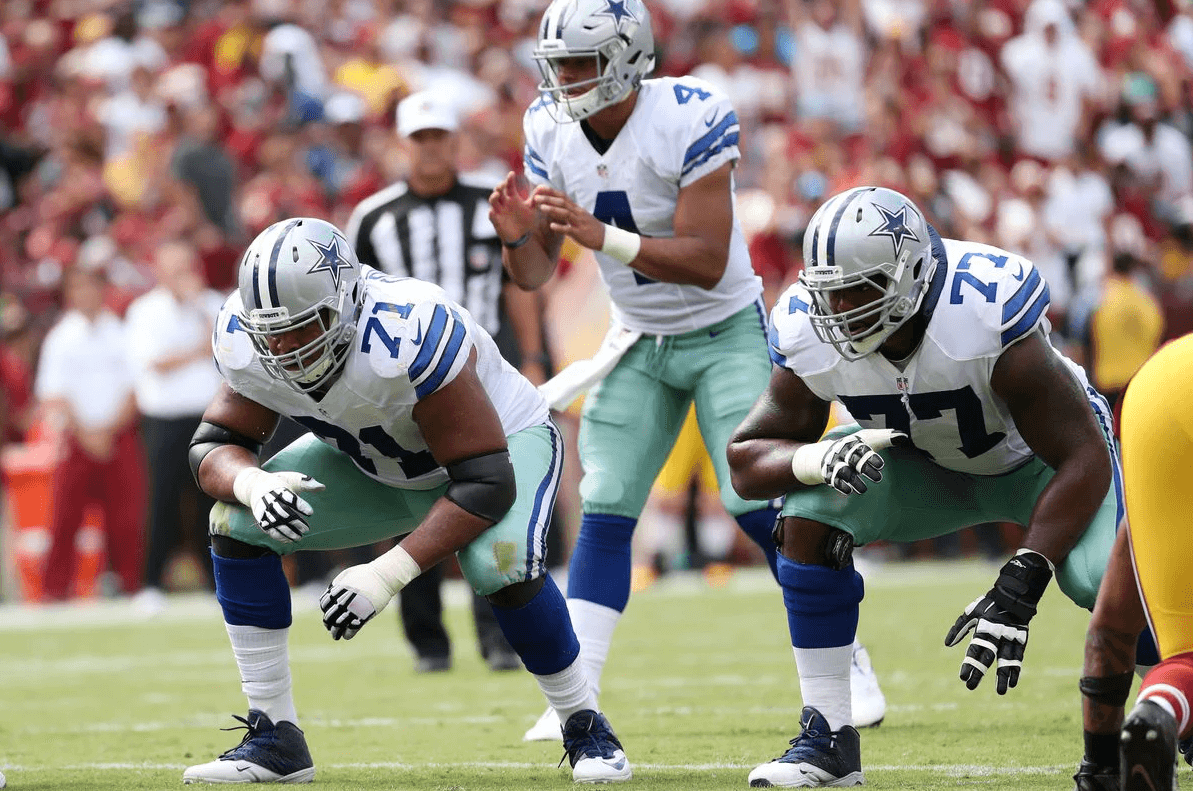
To succeed as an offensive lineman in the NFL, players need a rare combination of size, strength, agility, stamina, technique, communication skills, and intelligence.
Here are some of the most important attributes:
Size
Offensive linemen are among the largest players on the field. Top linemen typically weigh over 300 pounds and stand at least 6’3″. This size helps them block and overpower defensive players. Shorter linemen can struggle seeing over taller defenders.
Strength
Linemen need tremendous upper and lower body strength to drive block and control defenders. They build strength through weight training, power lifts like squats and deadlifts, and specialized drills. Strong hands and grip help maintain blocks.
Agility
Though big, linemen must move quickly and fluidly. They practice footwork drills to improve coordination and change direction rapidly when pulling across the line. Good linemen can slide and mirror fast defenders in pass protection.
Stamina
Blocking on every offensive snap demands great endurance. Linemen rotate less than other positions and often play nearly every down. Maintaining strength and technique while fatigued separates elite linemen.
Technique/Footwork
Proper footwork, hand placement, leverage, and blocking angles are essential. Linemen continuously refine subtleties like balance, pad level, timing, and blocking angles. Mastering techniques for both run and pass blocking is challenging.
Communication/Coordination
Offensive linemen must communicate protection calls and coordinate as a unit. Silent count and non-verbal cues help synchronize movements. Linemen identify defensive fronts and adjust to stunts and blitzes on the fly.
Run Blocking vs Pass Blocking
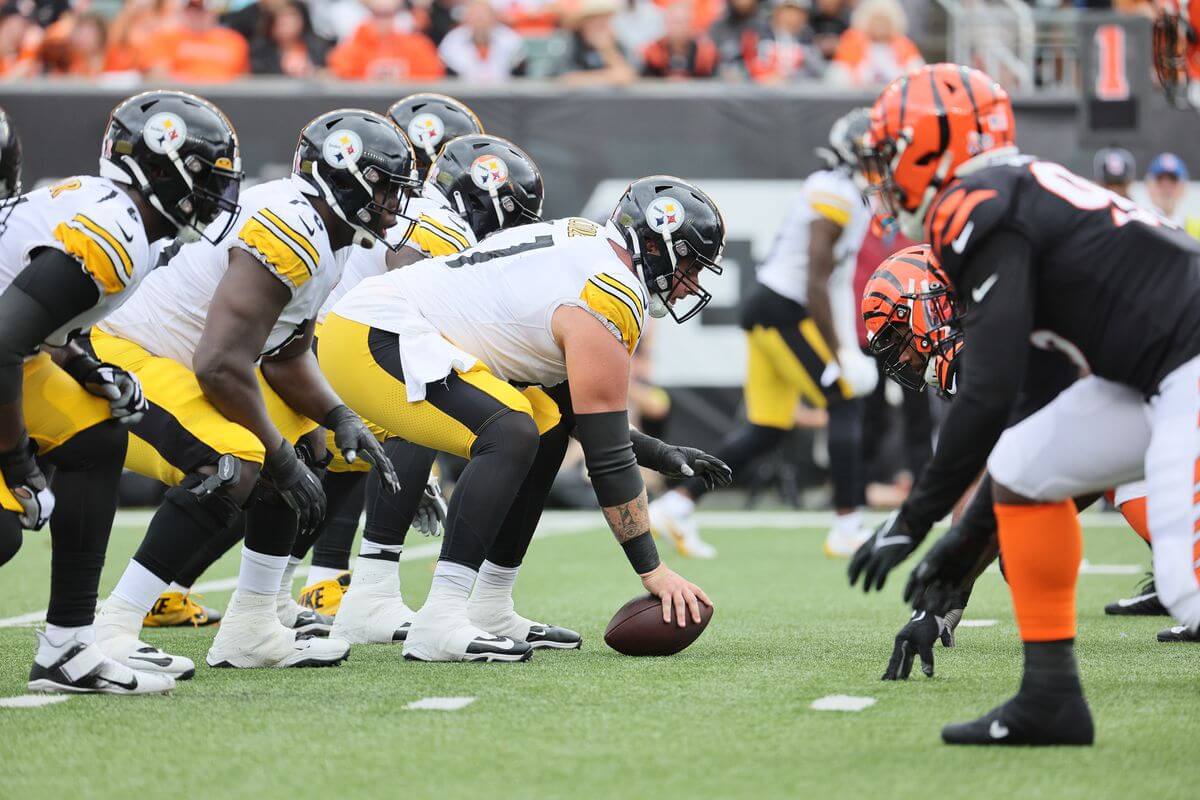
An offensive lineman’s techniques and responsibilities differ significantly between run blocking and pass blocking.
On running plays, the offensive linemen must fire out quickly from their stance to engage the defensive line and linebackers at the line of scrimmage. The goal is to drive the defenders away from the running lane to open up holes for the running back. Run blocking requires offensive linemen to be more aggressive, using leverage and leg drive to create a new line of scrimmage. Blocking angles are especially important on zone run schemes.
Pass blocking requires different techniques because the offensive linemen can’t be as aggressive. They must drop back in their stance to establish a pocket, absorb the pass rush, and anchor against bull rushes. Pass blocking is more of a mental and technical challenge. Offensive linemen must have quick feet to mirror shifty pass rushers while keeping their shoulders square. They also need strong hands to control rushers. Communication is critical to handle stunts and blitzes. The ultimate goal is holding blocks long enough for the quarterback to find an open receiver.
So while run blocking relies on physical dominance and aggression, pass blocking requires more finesse, balance, patience, and awareness. Offensive linemen must master both skill sets to open holes in the run game while providing a clean pocket on passing downs. The best linemen can seamlessly transition between these contrasting blocking techniques.
Famous Offensive Linemen
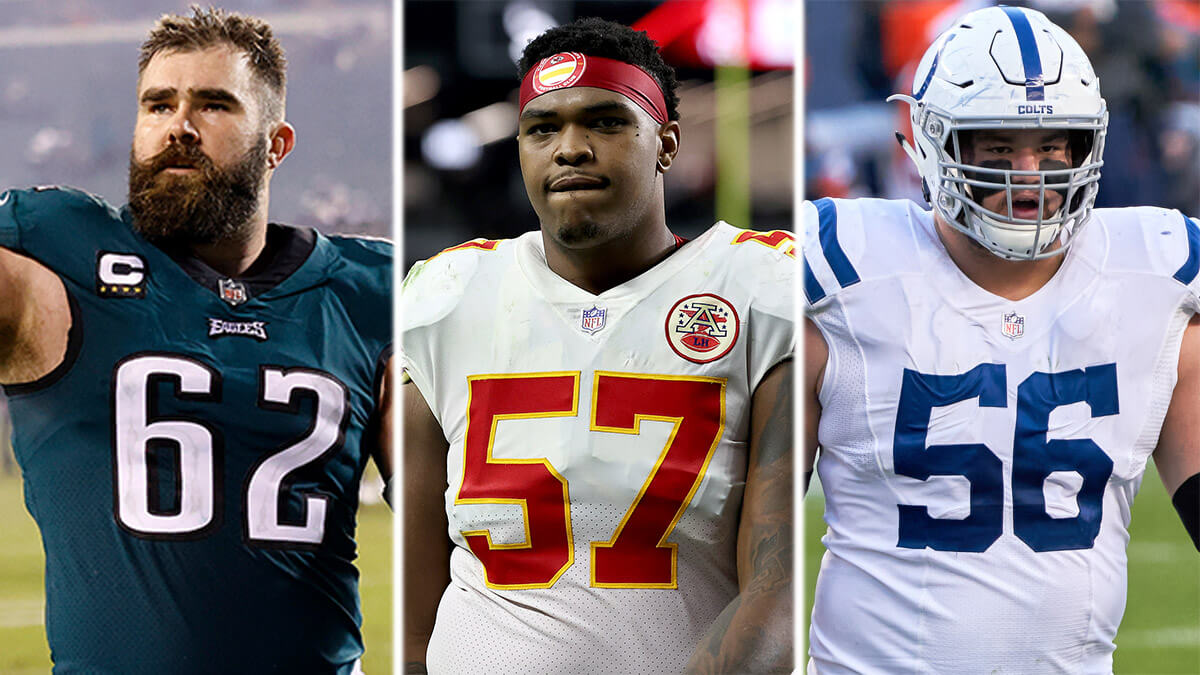
Some of the most well-known and talented offensive linemen in NFL history include:
- Anthony Muñoz – Muñoz played 13 seasons with the Cincinnati Bengals and is considered one of the greatest offensive tackles of all time. He was an 11-time Pro Bowler and 9-time First-team All-Pro selection who had incredible strength, footwork and technique. Muñoz was inducted into the Pro Football Hall of Fame in 1998.
- Bruce Matthews – Matthews had a remarkable 19-year career, spending all of it with the Houston / Tennessee Oilers / Titans organization. He played every position on the offensive line at a high level and was selected to 14 Pro Bowls. Matthews was inducted into the Hall of Fame in 2007.
- Walter Jones – Jones played 12 seasons for the Seattle Seahawks and was regarded as a dominant left tackle. He had excellent size and athleticism, which allowed him to neutralize even the best pass rushers. Jones was a 9-time Pro Bowler and 4-time First-team All-Pro. He entered the Hall of Fame in 2014.
- Willie Roaf – Roaf was an outstanding offensive tackle who played 13 seasons for the New Orleans Saints and Kansas City Chiefs. He was selected to 11 Pro Bowls and was named First-team All-Pro 7 times. Roaf was inducted into the Hall of Fame in 2012 for his rare combination of power, agility and technique.
- Mike Munchak – Munchak had a 12-year career with the Houston Oilers and was one of the premier guards of his era. He was selected to 9 Pro Bowls and was named First-team All-Pro 6 times. Munchak was inducted into the Hall of Fame in 2001 and later became a successful NFL head coach.
Salary and Contracts
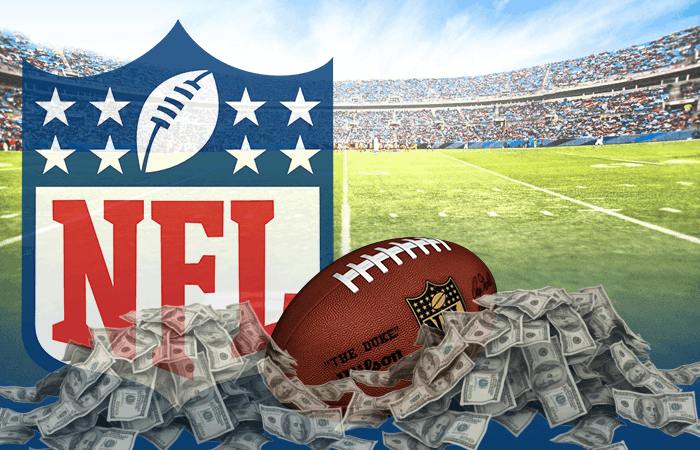
Offensive linemen are typically among the highest paid non-skill position players in the NFL. While not usually earning as much as star quarterbacks, running backs, or wide receivers, offensive linemen often sign lucrative long-term contracts. This is due to their importance in protecting the quarterback and opening running lanes.
The average salary for an NFL offensive lineman is around $2-4 million per year. However, elite offensive tackles and interior linemen can earn $10 million or more annually on their contracts.
Some of the highest paid offensive linemen in 2023 include:
- Laremy Tunsil, Houston Texans – $25,000,000 per year
- Andrew Thomas, New York Giants – $23,500,000 per year
- Trent Williams, San Francisco 49ers – $23,010,000 per year
- David Bakhtiari, Green Bay Packers – $23,000,000 per year
- Chris Lindstrom, Atlanta Falcons – $20,500,000 per year
2023 Offensive Line Average Rankings – Sportac.
Many offensive linemen sign large multi-year contracts to secure their services long-term.
Some recent big contracts include:
- Trent Williams: 6 years, $138,060,000 with San Francisco 49ers
- Andrew Thomas, 5 years – $117,500,000 with New York Giants
- Chris Lindstrom, 5 years – $102,500,000 with Atlanta Falcons
- Ronnie Stanley, 5 years – $98,750,000 with Baltimore Ravens
- Tyron Smith, 8 years – $97,600,000 with Dallas Cowboys
The significant investment in offensive linemen highlights their importance in today’s pass-heavy NFL. Teams are willing to commit major salary cap resources to ensure they have a talented offensive line to protect the quarterback and open holes for the running game. With their key role and high injury risk, offensive linemen often earn some of the biggest contracts for non-skill players.
Injuries and Health
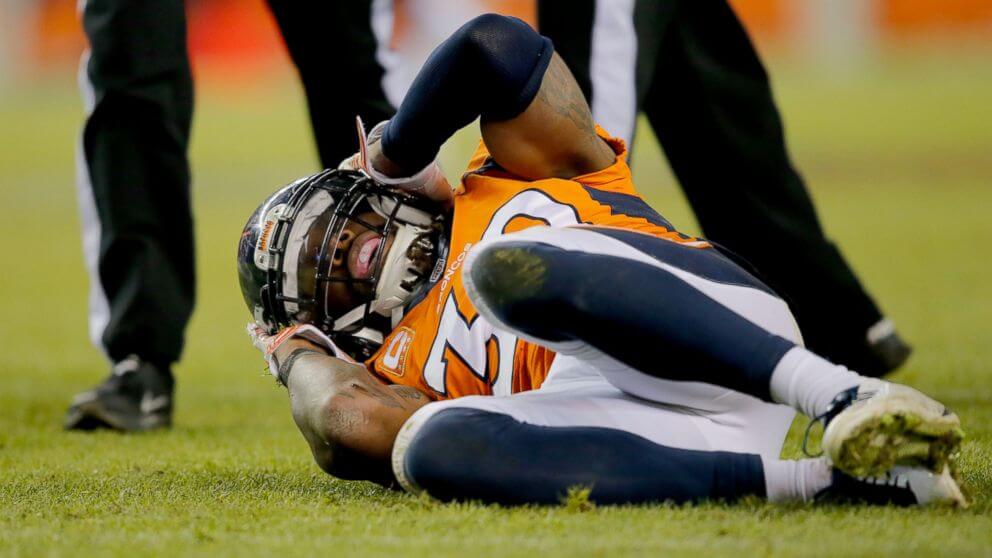
Offensive linemen put their bodies through immense physical strain on every play. As a result, they suffer from some of the highest injury rates in football.
Some of the most common injuries include:
- Knee injuries – Offensive linemen frequently suffer knee injuries such as ACL tears and meniscus tears due to the physical nature of their blocking duties. Sudden changes in direction and absorbing contact from defensive linemen puts a lot of stress on their knees.
- Ankle sprains – The ankles are vital for offensive linemen to maintain their balance and leverage against defenders. But ankles are prone to sprains and rolls, especially when linemen get tangled up with each other in the trenches.
- Back injuries – The spine endures a lot of compression and twisting forces from blocking duties. Back issues like herniated discs, spinal stenosis, and sciatica are common for offensive linemen. Maintaining proper lifting technique is critical.
- Head and neck injuries – Offensive linemen can suffer concussions from inadvertent helmet-to-helmet hits. And their necks must withstand frequent whiplash forces. Neck injuries can potentially be career threatening.
- Shoulder injuries – Dislocated shoulders and rotator cuff tears often occur from reaching and punching while blocking defenders. The shoulders are especially vulnerable on pass blocking dropbacks.
To withstand this physical punishment, offensive linemen must adhere to strict strength and conditioning programs. Proper technique, flexibility, and injury treatment are also important. Offensive linemen are some of the biggest and fittest players in football. But health remains a primary concern for maintaining their performance.
Offensive Line Rankings and Statistics
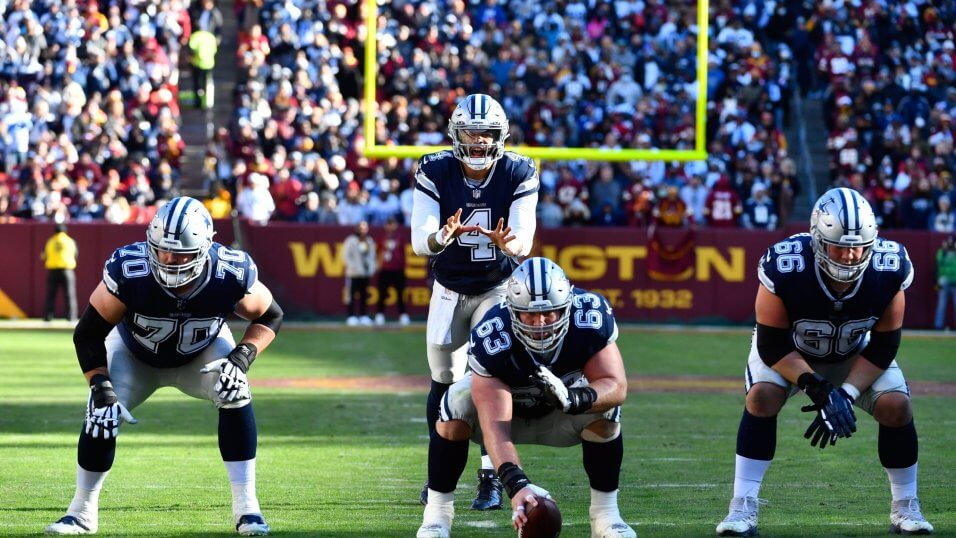
The offensive line is arguably the most important unit in football. Their performance can make or break a team’s offense and determine how far they go each season. While individual offensive linemen don’t fill the stat sheets, there are some useful statistics and rankings to evaluate offensive lines as a whole.
Sacks Allowed: One of the most telling stats for offensive lines is the number of sacks they allow. Lines that give up fewer sacks do a better job protecting the quarterback and giving him time to throw.
Some of the best offensive lines in 2021 allowed very few sacks:
- Tampa Bay Buccaneers – 22
- Indianapolis Colts – 24
- New England Patriots – 28
Rushing Yards: The number of rushing yards a team gains is also heavily dependent on the offensive line’s run blocking. The best lines open up holes and get push at the line of scrimmage to allow running backs to gain chunk yardage.
The top rushing teams in 2021 were:
- Indianapolis Colts – 2,540 yards
- Philadelphia Eagles – 2,715 yards
- Dallas Cowboys – 2,796 yards
Adjusted Line Yards: Football Outsiders uses a metric called Adjusted Line Yards that measures each offensive line’s contribution to the team’s rushing yards.
Teams with the top Adjusted Line Yards in 2021 were:
- Cleveland Browns – 4.95
- Dallas Cowboys – 4.93
- Indianapolis Colts – 4.74
Rankings like these help assess which offensive lines are controlling the line of scrimmage and imposing their will in the run game.
Pass Block Win Rate: ESPN tracks Pass Block Win Rate which measures how often each offensive line prevents pressure within 2.5 seconds of the snap.
The best pass blocking teams by this metric in 2021 were:
- Green Bay Packers – 68%
- Tampa Bay Buccaneers – 67%
- New England Patriots – 65%
By looking at pressure rate and pass blocking stats, we can determine which offensive lines excel at keeping their quarterbacks upright and giving them a clean pocket. The very best offensive lines dominate in both run and pass blocking.
Conclusion
Offensive linemen are essential players on a football team’s offense. Their main role is to block and protect the quarterback and running backs, acting as the first line of engagement with the defense.
A good offensive line is critical for a successful offense. They are responsible for opening up running lanes and providing the quarterback enough time in the pocket to pass. Offensive linemen rarely touch the football or score touchdowns, but their impact allows skill players to make big plays.
The five positions on the offensive line are center, guards and tackles. They must be big, strong and quick on their feet. Key attributes include size, strength, agility, footwork, hand placement and technique. Successful offensive linemen require extensive practice and coordination as a unit.


